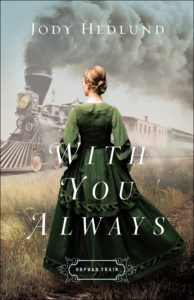Jody Hedlund continues to be one of my favorite historical fiction authors. Her new Orphan Train series kicks off with a page-turning story of family love and loyalty in With You Always.
 Elise Neumann is caring for her younger sisters in 1850s New York and after a week of living on the streets, they find refuge in a women’s mission. Temporarily. But when a financial crisis strikes the city, the jobs for women dry up and Elise is forced to make a decision to leave her family and find work in the Midwest, where towns are developing along the newly constructed Illinois Central Railroad. It isn’t everything she hoped and speaking her mind lands her in some trouble with the land developer’s assistant and her hope of a brighter future for her family dims.
Elise Neumann is caring for her younger sisters in 1850s New York and after a week of living on the streets, they find refuge in a women’s mission. Temporarily. But when a financial crisis strikes the city, the jobs for women dry up and Elise is forced to make a decision to leave her family and find work in the Midwest, where towns are developing along the newly constructed Illinois Central Railroad. It isn’t everything she hoped and speaking her mind lands her in some trouble with the land developer’s assistant and her hope of a brighter future for her family dims.
The man developing the town where Elise is working is Thornton Quincy, a member of an elite New York society family who has been pitted against his twin brother for their father’s inheritance. They’re challenged to build a sustainable town along the railroad and win the heart of a woman suitable for marriage before six months has passed. Thornton is driven to accomplish the task before his brother and win not only the challenge but his father’s approval.
It’s historical romance, so of course, Thornton takes notice of Elise and is drawn to her outspoken nature and her passion for ethical and fair treatment of the workers. As their relationship develops, they both struggle with the differences in their stations in life.
Whether they can move past those differences is what keeps the pages turning. (Disclaimer: I received a free copy of the book from the publisher. Opinions shared in this review are my honest ones.)
Elise is one of my favorite of Jody’s characters. She is spunky and not at all weak. And I love the banter between her and Thornton. This is one of Jody’s strengths in developing characters–dialogue. I also loved that part of this story took place in Illinois. Most of Jody’s books, at least recently, are set in Michigan and as a native Illinoisan, I love seeing my home state in fiction.
This book is the first in a series about orphan trains, a subject I don’t know much about but want to now that I’ve read a little bit. Jody’s books generally introduce me to a historical event or topic that I want to study further. Anther of her strengths.
As a bonus, here are a few Q&As from the author about the book. 
What is the inspiration behind your new Orphan Train series?
I have long been fascinated by the era of the Orphan Trains and the heart-wrenching stories of the homeless and helpless young orphans that were taken from the streets of New York City and other eastern cities and shipped West by the dozens. I was familiar with stories of those scared orphans who were placed out in what was thought to be a more wholesome, healthy environment of the newly settled Mid-Western states. Some of the orphans found happy endings and were adopted into loving families. Others experienced great abuse and heartache in their new homes.
While stories of the orphans who rode the trains have been told—and rightly so—the stories of the women who were involved in the movement are not as well known. One of the things I particularly like to do when telling my stories, is focus on women who have been overlooked by the pages of history. I consider it a great privilege to be able to bring forgotten women to life for our modern generation. Thus, throughout this series, I’ll be focusing each book on a different aspect of the Orphan Train movement, particularly from the perspective of women who experienced riding the trains in one form or another.
2. An e-novella, An Awakened Heart, kicks off the series. What is the novella about, and is it a must-read in order to understand the series?
An Awakened Heart is not a must-read in order to understand the series. But I do highly recommend reading it. (Plus it’s FREE, so you have nothing to lose by giving it a try!) The e-novella introduces a couple, Guy and Christine, who are both passionate about helping the poor immigrants crowded into the overflowing and dirty tenements of New York City. The novella shows their efforts to bring about change in the city, but also brings them together in a satisfying love story.
The novella also introduces the three orphan sisters who will each become main characters for the three full-length novels in the series. It gives some of the background information on their situation, particularly how they become orphans, which I think readers will find helpful as well as informative.
3. How did you come up with the idea for the first book in the series, With You Always?
For this first book in the series, I decided to base the story around the placing out of women that happened in 1857 as a result of a financial crisis and economic panic in the autumn of that year. Women laborers were already at a disadvantage with poor working conditions and low wages. In September of 1857, estimates of New York unemployment ran as high as forty percent. Female employment was cut by almost half. With prostitution already a main source of income for many women, the recession drove even more to desperate measures and the number of women in prison rose as well.
To meet the growing crisis, the Children’s Aid Society in New York, along with organizations in other cities, who were already sending children West, decided to set up special placement offices to find jobs for seamstresses and trade girls in the West. The associations only wanted women of “good character” and they were required to provide references. If the women met the qualifications, then they were sent on trains to towns in Mid-Western states, particularly central Illinois where the demand for cheap labor was prevalent. They were presented to western employers as “helpless females left without the means of support.” Placement of these women continued until the spring of 1858.
It was my hope through the first book in the series, With You Always, to give readers a glimpse into the disadvantage of women during this particular era by showing the heroine Elise Neumann’s struggle, first in New York City and then also the continued heartache and problems that arose after leaving her family behind so that she could attempt to start a new life in central Illinois.
4. What special research did you do in writing With You Always?
In the beginning phases of writing this series, I did a great deal of reading about the orphan train movement. In particular, I really loved Stephen O’Conor’s book, Orphan Trains, because he includes so many personal stories and details about real orphans, which are heart wrenching.
I also read, A History of New York City to 1898, by Burrows and Wallace, which gave me great insights into the lives of immigrants, particularly immigrant women. Masses of foreigners were arriving into New York City on a daily basis, and the book gave a detailed look into their pathetic housing situation, the difficult working conditions, as well as gang problems and the underworld.
Finally, another important aspect of the story that required a concentrated amount of research was the development of railroads. The mid-1800’s was an incredible period of growth for the railroad industry in the Mid-West. The new railroads aided the orphan train movement but also brought about the settlement of the Midwestern states, including Illinois, which is one of the settings of the book.
5. Many of your previous stories are set in Michigan. With You Always takes place in both New York City as well as Illinois. Why did you decide to change settings?
I definitely could have used Michigan as the Mid-western setting for this book since the very first orphan train went to Dowagiac, a small town in southwestern Michigan. However, as I studied railroads and town development, I decided that the plains of central Illinois would really add to the story, especially because the Illinois Central Railroad (IC) was built between 1851 and 1856 during the time of my story.
With this new railroad that ran the length of Illinois from north to south, investors were looking at attempting to build towns along the railroad in order to attract new settlers who would use the railroad. Since my hero, Thornton Quincy, is involved in the development of the IC, he and his family have an invested interest in seeing the growth of towns along the new railroad. Adding in a competition with Thornton’s twin brother for the development of one such town made the story and setting in Illinois come alive.
I also loved having my heroine, Elise Neumann, be able to travel from the crowded dirty streets of New York City to the plains of Illinois where she experienced a culture shock. She’s taken from a bustling city life to an isolated farming town that consists of only a few buildings when she arrives.
What are you working on next?
The second book in the orphan train series releases next summer in 2018. The story continues with Marianne Neumann. She gets involved in the orphan train movement as one of the placing agents and accompanies the orphans as they ride the trains west. I hope readers will enjoy Marianne’s story and also appreciate learning more about the orphan train movement from the eyes of the compassionate workers who tried to place the orphans into new homes.
Find out more about Jody and connect with her online in these places:
Facebook: Author Jody Hedlund
Twitter: @JodyHedlund
Website: jodyhedlund.com
Instagram: instagram.com/jodyhedlund/
Pinterest: pinterest.com/jodyhedlund/pins/
